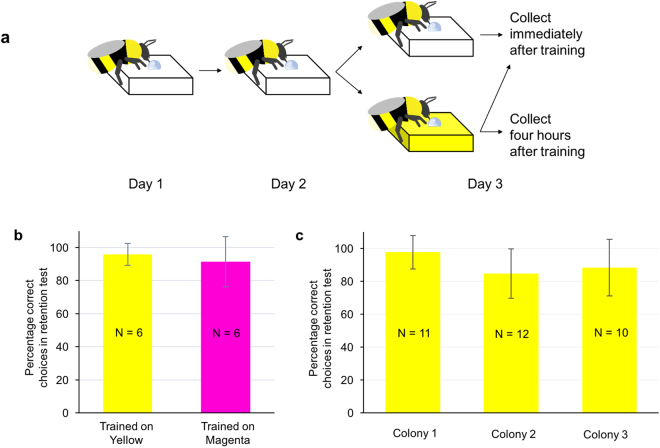Figure 1.
Training procedure and establishment of long-term memory with absolute conditioning. (a) Training procedure. Bees were trained individually to forage on one transparent chip, which contained 100 µl 40% sucrose solution (five trips with 10 min inter-trip intervals on each of two consecutive days). On day three, bees were trained to visit a chip containing 100 µl 40% sucrose solution five trips (with 10 min inter-trip interval) in one of three conditions: visiting a transparent chip and collected immediately after training (0-hour Control); visiting a yellow chip and collected immediately after training (0-hour Learning); visiting a yellow chip and kept in the hive for four hours without any further foraging experience prior to collection (4-hour Learning). (b) Bees form a long-term memory of a colour trained under absolute conditioning, irrespective of the colour trained. Bees discriminated the conditioned colour from a novel colour during a memory retention test (t-test, Yellow: t = 16.90, df = 5, p = 0.000; Magenta: t = 6.64, df = 5, p = 0.001, compared to chance expectation 50%). Accuracy did not differ between yellow and magenta (t-test, t = 0.65, df = 10, p = 0.532). (c) Bees’ memory performance did not differ across colonies. Bees in all three colonies formed long-term memory after training (t-test, Colony 1: t = 15.50, df = 10, p = 0.000; Colony 2: t = 8.05, df = 11, p = 0.000; Colony 3: t = 7.04, df = 9, p = 0.000, compared to chance expectation 50%) and bees performance on the memory retention test did not differ between the three colonies used for sequencing (one-way ANOVA, F(2, 30) = 2.14, p = 0.136). The number within each bar indicates the number of bees tested. Vertical bars indicate standard deviation.

